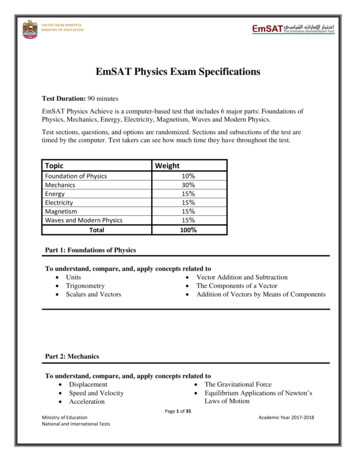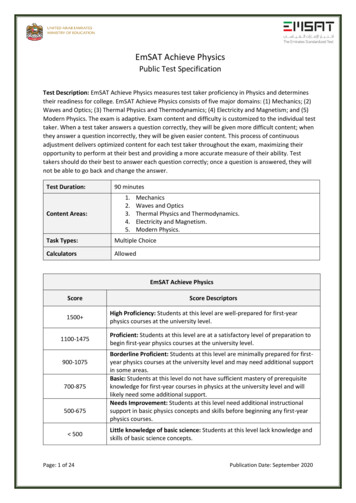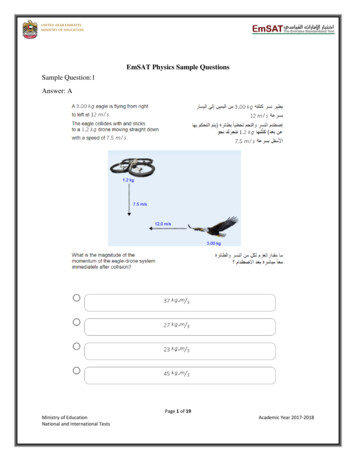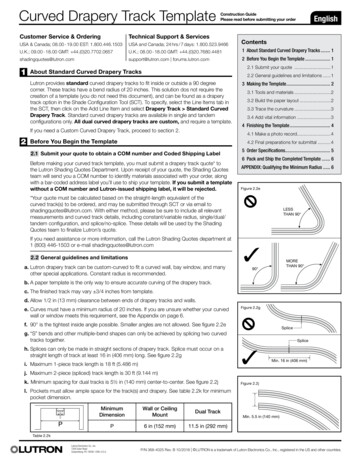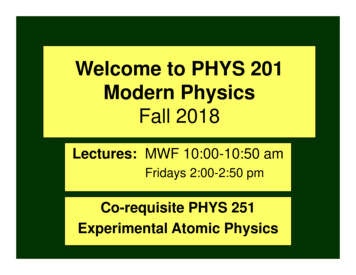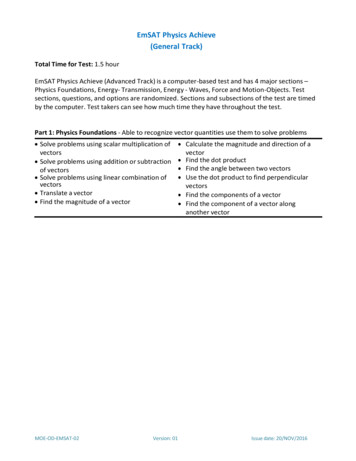
Transcription
EmSAT Physics Achieve(General Track)Total Time for Test: 1.5 hourEmSAT Physics Achieve (Advanced Track) is a computer‐based test and has 4 major sections –Physics Foundations, Energy‐ Transmission, Energy ‐ Waves, Force and Motion‐Objects. Testsections, questions, and options are randomized. Sections and subsections of the test are timedby the computer. Test takers can see how much time they have throughout the test.Part 1: Physics Foundations ‐ Able to recognize vector quantities use them to solve problems Solve problems using scalar multiplication ofvectors Solve problems using addition or subtractionof vectors Solve problems using linear combination ofvectors Translate a vector Find the magnitude of a vectorMOE‐OD‐EMSAT‐02 Calculate the magnitude and direction of avector Find the dot product Find the angle between two vectors Use the dot product to find perpendicularvectors Find the components of a vector Find the component of a vector alonganother vectorVersion: 01Issue date: 20/NOV/2016
Part 2: Energy‐Transmission ‐ Describe transmission of various forms of energyo Understand that heat moves inpredictable ways, flowing from warmerobjects to cooler objects until both reachthe same temperatureo Know that heat can be transferredthrough matter by the collisions ofatoms and/or molecules (conduction) orthrough space (radiation)o Understand during a phase change, heatenergy is absorbed or releasedo Understand that most substances expandwhen heated and contract when cooledo Know that temperature affects thesolubility of some substances in watero Know the energy cannot be created ordestroyed, but only changed from one forminto anothero Understand that energy can changefrom one form to another, although inthe process some energy is alwaysconverted to heatMOE‐OD‐EMSAT‐02Version: 01o Understand all energy transfers aregoverned by the law of conservation ofenergyo Understand that energy may be convertedamong mechanical, electromagnetics,nuclear, and thermal formso Know that potential energy is the energyan object possesses by its position orcondition such as gravitational and elastico Know that kinetic energy is the energy anobject possesses by its motiono Understand an ideal mechanical system isthe sum of the macroscopic kinetic andpotential energies is constanto Understand when work is done or by asystem, there is change in the total energyof the systemo Understand that work done against frictionresults in an increase in the internal energyof the systemo Know that power is the time‐rate at whichwork is done or energy is expendedIssue date: 20/NOV/2016
Section: 2, Sample Question: 1Answer: CMOE‐OD‐EMSAT‐02Version: 01Issue date: 20/NOV/2016
Section: 2, Sample Question: 2Answer: AMOE‐OD‐EMSAT‐02Version: 01Issue date: 20/NOV/2016
Section: 2, Sample Question: 3Answer: 0.34MOE‐OD‐EMSAT‐02Version: 01Issue date: 20/NOV/2016
Section: 2, Sample Question: 4Answer: BMOE‐OD‐EMSAT‐02Version: 01Issue date: 20/NOV/2016
Section: 2, Sample Question: 5Answer: 782.8MOE‐OD‐EMSAT‐02Version: 01Issue date: 20/NOV/2016
Part 3: Energy‐Waves ‐ Explain variations in wavelength and frequency in terms of thesources of the vibrations that produce them, e.g., molecules, electrons, and nuclearparticles Know that different forms of electromagnetic Know that resonance occurs when energyenergy have different wavelengthsis transferred to a system at its natural Understand that light passes through somefrequencymaterials, sometimes refracting in the Knowwhen a wave strikes a boundaryprocessbetween two media, reflection, Know that electrical energy can be producedtransmission, and absorption occurfrom a variety of energy sources and can be Knowthe absolute index of refractions istransformed into almost any other form ofinversely proportional to the speed of aenergywave Know that electrical circuits provide a meansof transferring electrical energy Know all frequencies of electromagnetic Understand that material that has beenradiation travel at the same speed in aelectrically charged attracts unchargedvacuummaterial, and may either attract or repel Know diffraction occurs when waves passother charged materialby obstacles or through openings Know that a magnet attracts certain materials Understand when waves of similar natureand either attracts or repels other magnetsmeet, the resulting interference may be Know that an oscillating system producesexplained using the principle ofwavessuperposition Know that waves carry energy and Understand when a wave source and aninformation without transferring massobserver are in relative motion, the Understand that waves incorporate theobserved frequency of the waves travelingcharacteristics of amplitude, wavelength,between them is shiftedfrequency, period, wave speed, and phase Know that mechanical waves require amaterial medium through which to travel Understand that waves are categorized bythe direction in which particles in a mediumvibrate about an equilibrium position relativeto the direction of propagation of the waveMOE‐OD‐EMSAT‐02Version: 01Issue date: 20/NOV/2016
Section: 3, Sample Question: 1Answer: BMOE‐OD‐EMSAT‐02Version: 01Issue date: 20/NOV/2016
Section: 3, Sample Question: 2Answer: BMOE‐OD‐EMSAT‐02Version: 01Issue date: 20/NOV/2016
Section: 3, Sample Question: 3Answer: 1Section: 3, Sample Question: 4Answer: BMOE‐OD‐EMSAT‐02Version: 01Issue date: 20/NOV/2016
Section: 3, Sample Question: 5Answer: AMOE‐OD‐EMSAT‐02Version: 01Issue date: 20/NOV/2016
Part 4: Force and Motion‐Objects ‐ Explain and predict different patterns of motion of objects(e.g. linear and uniform circular motion, velocity and acceleration, momentum and inertia) Know the motion of an object is always Understand that a projectile's time injudged with respect to some otherflight is dependent upon the verticalobject or pointcomponents of its motion Know the motion of an object can be Know the horizontal displacement ofdescribed by its position, direction ofa projectile is dependent upon themotion, and speedhorizontal components of its motion Understand an object's motion is theand its time of flightresult of the combined effect of all Understand the inertia of an object isdirectly proportional to its mass (NFL)forces acting on the object Know when the net force on a system Know that force is directly related to anis zero, the system is in equilibriumobject's mass and acceleration Understand an unbalanced force Know that for every action there is anequal and opposite reactioncauses a mass to accelerate (NSL) Understand that every object exerts Know weight is the gravitational forcewith which a plant attracts a massgravitational force on every other Understandthe elongation orobjectcompression of a spring depends Know the electric currents andupon its spring constant and themagnets can exert a force on eachmagnitudeof the applied forceother Know that centripetal forces are the Understand that machines transfernet force which produces centripetalmechanical energy from one object toaccelerationanother Knowthat kinetic friction is a force that Know that Friction is a force thatopposes motionopposes motion Understand an impulse acting on an Understand that a machine can beobject causes a change in itsmade more efficient by reducingmomentumfriction Understandthat forces occur in Understand that machines can alteraction/reaction pairs (NTL)the direction or amount of force, or Know that momentum is conserved inthe distance or speed of forcea closed systemrequired to do work Understand field strength and direction Understand the basic differencesbetween simple and complex machinesare determined using a test particle Know that gravitational forces are only Understand that an object in linearattractive, whereas electrical andmotion may travel with a constantmagnetic forces can be attractive andvelocity or with accelerationo repulsive Understand that an object in free fall Know the inverse square law appliesaccelerates due to the force of gravityto electrical and gravitational fields Know the path of a projectile is theproduced by point sourcesresult of the simultaneous effect ofthe horizontal and verticalcomponents of its motionMOE‐OD‐EMSAT‐02Version: 01Issue date: 20/NOV/2016
Section: 4, Sample Question: 1Answer: DMOE‐OD‐EMSAT‐02Version: 01Issue date: 20/NOV/2016
Section: 4, Sample Question: 2Answer: DMOE‐OD‐EMSAT‐02Version: 01Issue date: 20/NOV/2016
Section: 4, Sample Question: 3Answer: 2.62MOE‐OD‐EMSAT‐02Version: 01Issue date: 20/NOV/2016
Section: 4, Sample Question: 4Answer: CMOE‐OD‐EMSAT‐02Version: 01Issue date: 20/NOV/2016
Section: 4, Sample Question: 5Answer: BMOE‐OD‐EMSAT‐02Version: 01Issue date: 20/NOV/2016
EmSAT Physics Achieve (General Track) Total Time for Test: 1.5 hour EmSAT Physics Achieve (Advanced Track) is a computer‐based test and has 4 major sections – Physics Foundations, Energy‐ Tra
